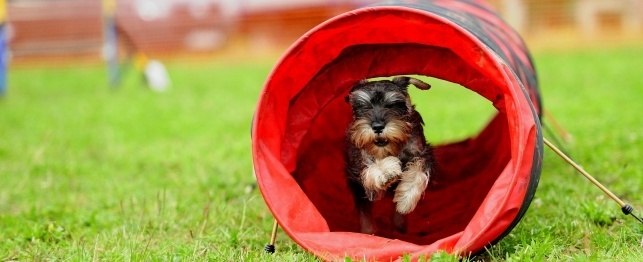The idea that dog commands are best when spoken is a very long held belief and many pet owners have never thought to use a hand signal or other body language when training their pet. Fortunately, the trends in dog training are changing, and most professional dog trainers that you might meet will tell you that hand signals are as effective as, if not more effective than, vocal commands.
Hand signals have been heralded as a great idea in dog training simply because they are very effective and easy to perform. The thinking came about due to the fact that barking only form a small part of canine communication. Vocalizations in a dog are useful at a distance, but dogs bark at each other far less when in close proximity to one another than when they are some distance away. When two dogs meet up, body language is often used to communicate. A dog's body language and facial expression can communicate a great deal of information to another dog. Although it is useful to know, it is not necessary for a dog owner to understand everything about your dog's body language.
Certainly dogs listen and can hear, but a dog is much more comfortable reading their owner's expressions and motions. Hand signals are much closer to a dog's natural communication than a spoken signal, so you may find that your dog responds much better and more quickly to a hand signal.
Your first step is simply to choose those signals that your will use for each command. Make sure you have decided on your signals before you begin training, as changing the signals mid-training will only serve to confuse your dog. The hand signals need to be clear to begin with. Your dog will not understand or take a longer time to learn signals that look similar. Signals such as a fist or an open hand are some examples of effective hand signals.
Begin by rewarding your dog every time he does the correct action. For example, praise your dog and offer him a treat when he gets the command right. Start to incorporate the hand signals in. When your dog lies down, show the hand signal at the same time as you say your command. After that offer treat and praise accordingly. After some time, you can start to practice showing the hand signals only. There are a lot of tricks that can be used to get a dog to perform the correct actions such as holding a treat in a fist above your dog's head to get him to sit, or holding a treat at the floor to get him to lie down, all while using the hand signal.
It will not be too long before you realize that your dog can associate the commands with the hand signals. Do note that punishing your dog by means of shouting and hitting is not productive. Dogs are known to respond best when you use positive reinforcement and rewards at the right time. Avoid punishing your dog if he fails to perform a command as that will slow your training further.

 Thanksgiving Dangers: Tips to Prevent Common Problems in Your Dog
Thanksgiving Dangers: Tips to Prevent Common
Thanksgiving Dangers: Tips to Prevent Common Problems in Your Dog
Thanksgiving Dangers: Tips to Prevent Common
 Canine Cushings Disease Diet
Canine
Canine Cushings Disease Diet
Canine
 Shopping List for Your Puppy
Shopping List for Your Puppy
Shopping List for Your Puppy
Shopping List for Your Puppy
 Kennel Cough in Dogs: Symptoms and Treatment
Kennel
Kennel Cough in Dogs: Symptoms and Treatment
Kennel
 Suffocation Hazards for Dogs
Suffocation Hazards for Dogs
Suffocation Hazards for Dogs
Suffocation Hazards for Dogs